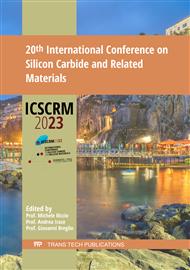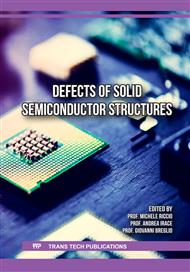[1]
N.T. Son, X.T. Trinh, L.S. Løvlie, B.G. Svensson, K. Kawahara, J. Suda, T. Kimoto, T. Umeda, J. Isoya, T. Makino, T. Ohshima, and E. Janzén, "Negative-U system of carbon vacancy in 4H–SiC," Phys. Rev. Lett. 109, 187603 (2012).
DOI: 10.1103/physrevlett.109.187603
Google Scholar
[2]
P.B. Klein, B.V. Shanabrook, S.W. Huh, A.Y. Polyakov, M. Skowronski, J.J. Sumakeris, M.J. O'Loughlin; Lifetime-limiting defects in n− 4H-SiC epilayers. Appl. Phys. Lett. 30 January 2006; 88 (5): 052110.
DOI: 10.1063/1.2170144
Google Scholar
[3]
L. Storasta, P. Bergman, E. Janzén, and C. Hallin, Mater. Sci. Forum 389-393, 549 (2002).
DOI: 10.4028/www.scientific.net/msf.389-393.549
Google Scholar
[4]
Misagh Ghezellou, Piyush Kumar, Marianne E. Bathen, Robert Karsthof, Einar Ö. Sveinbjörnsson, Ulrike Grossner, J. Peder Bergman, Lasse Vines, Jawad Ul-Hassan; The role of boron related defects in limiting charge carrier lifetime in 4H–SiC epitaxial layers. APL Mater. 1 March 2023; 11 (3): 031107.
DOI: 10.1063/5.0142415
Google Scholar
[5]
Blood P and J. W Orton, The Electrical Characterization of Semiconductors: Majority Carriers and Electron States, Academic Press 1992, p.433.
Google Scholar
[6]
K. Tian, J. Via, K. Elgammal, A. Schöner, W. Kaplan, R. Karhu, J. Ul-Hassan, A. Hallén. Modelling the static on-state current voltage characteristics for a 10 kV 4H-SiC PiN diode. Material Science in Semiconductor Processing 115, 105097 (2020).
DOI: 10.1016/j.mssp.2020.105097
Google Scholar
[7]
E Omotoso et al 2020 Mater. Res. Express 7 025901.
Google Scholar
[8]
https://www.ioffe.ru/SVA/NSM/Semicond/SiC/bandstr.html.
Google Scholar
[9]
Bathen, M.E.; Galeckas, A.; Müting, J.; Ayedh, H.M.; Grossner, U.; Coutinho, J.; Frodason, Y.K.; Vines, L. Electrical charge state identification and control for the silicon vacancy in 4H-SiC. NPJ Quantum Inf. 2019, 5, 111.
DOI: 10.1038/s41534-019-0227-y
Google Scholar
[10]
Capan, I.; Brodar, T.; Pastuović, Z.; Siegele, R.; Ohshima, T.; Sato, S.I.; Makino, T.; Snoj, L.; Radulović, V.; Coutinho, J.; et al. Double negatively charged carbon vacancy at the h- and k-sites in 4H-SiC: Combined Laplace-DLTS and DFT study. J. Appl. Phys. 2018, 123, 161597.
DOI: 10.1063/1.5011124
Google Scholar
[11]
Capan, I.; Brodar, T.; Coutinho, J.; Ohshima, T.; Markevich, V.P.; Peaker, A.R. Acceptor levels of the carbon vacancy in 4 H-SiC: Combining Laplace deep level transient spectroscopy with density functional modeling. J. Appl. Phys. 2018, 124, 245701.
DOI: 10.1063/1.5063773
Google Scholar
[12]
Capan, I.; Brodar, T.; Yamazaki, Y.; Oki, Y.; Ohshima, T.; Chiba, Y.; Hijikata, Y.; Snoj, L.; Radulović, V. Influence of neutron radiation on majority and minority carrier traps in n-type 4H-SiC. Nucl. Inst. Methods Phys. Res. 2020, B478, 224–228.
DOI: 10.1016/j.nimb.2020.07.005
Google Scholar
[13]
Blood P and J. W Orton, The Electrical Characterization of Semiconductors: Majority Carriers and Electron States, Academic Press 1992, p.567.
Google Scholar
[14]
Blood P and J. W Orton, The Electrical Characterization of Semiconductors: Majority Carriers and Electron States, Academic Press 1992, p.639.
Google Scholar



